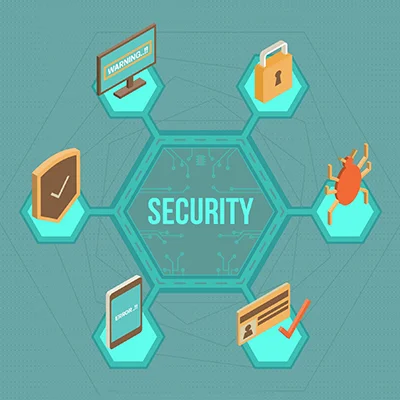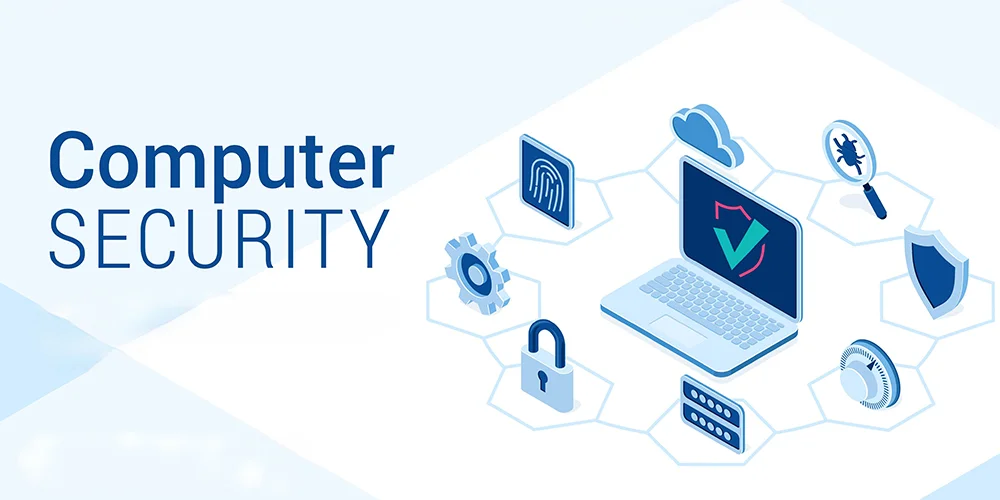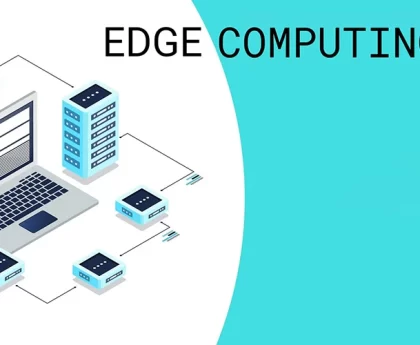Computer Security: often referred to as cybersecurity or information security, is the practice of protecting computer systems, networks, and data from unauthorized access, disclosure, alteration, or destruction. Its primary objective is to ensure the confidentiality, integrity, and availability of digital information and computing resources. Computer security encompasses a wide range of measures and technologies designed to safeguard computers and related infrastructure from a variety of threats and vulnerabilities, including:
Types of Computer Security
Computer security can be categorized into various types or aspects, each addressing specific concerns and challenges in safeguarding digital information and systems.
Here are some common types of computer security:
- Network Security:
– Firewalls: Network firewalls are designed to monitor and filter network traffic to prevent unauthorized access and protect against network-based attacks.
– Intrusion Detection and Prevention Systems (IDPS): These systems monitor network traffic for suspicious activity and can either alert administrators or take automated action to block threats.
– Virtual Private Networks (VPNs): VPNs establish secure encrypted connections over public networks to ensure the confidentiality of data transmitted between remote locations. - Endpoint Security:
– Antivirus Software: Protects individual devices (endpoints) from malware and viruses.
– Host-based Intrusion Detection and Prevention Systems (HIDPS): Monitors activities on individual devices to detect and prevent malicious behavior. - Application Security:
– Secure Software Development: Implementing secure coding practices to prevent vulnerabilities in software applications.
– Web Application Security: Protecting web applications from common threats like SQL injection, cross-site scripting (XSS), and cross-site request forgery (CSRF). - Data Security:
– Encryption: Securing data by converting it into an unreadable format that can only be decrypted by authorized users.
– Access Control: Restricting and controlling who can access and modify sensitive data.
– Data Loss Prevention (DLP): Monitoring and preventing unauthorized data transfers or leaks. - Cloud Security:
– Cloud Access Security Broker (CASB): Provides security policy enforcement for cloud services and applications.
– Identity and Access Management (IAM): Controls user access to cloud resources and data. - Physical Security:
– Biometrics: Using physiological or behavioral characteristics like fingerprints or facial recognition for access control.
– Surveillance: Monitoring physical locations with cameras and sensors. - Mobile Device Security:
– Mobile Device Management (MDM): Managing and securing mobile devices used within an organization.
– Mobile App Security: Ensuring the security of applications developed for mobile devices. - Incident Response and Management:
– Security Incident Response Plan (SIRP): Procedures for identifying, responding to, and mitigating security incidents.
– Forensics: Investigating and analyzing security incidents to understand the extent and impact of a breach. - Security Awareness and Training:
– Educating users and employees about security best practices and potential threats. - IoT (Internet of Things) Security:
– Protecting the security of interconnected IoT devices and networks.
These are just some of the major categories of computer security, and each may involve a range of technologies, processes, and best practices to effectively mitigate risks and protect digital assets. The specific security measures employed depend on an organization’s needs, the nature of its data and systems, and the evolving threat landscape.

Benefits of Computer Security
Computer security provides a wide range of benefits to individuals, organizations, and society as a whole.
Here are some of the key benefits of computer security:
- Protection of Data: Computer security safeguards sensitive and confidential data from unauthorized access, theft, or disclosure. This includes personal information, financial records, intellectual property, and other critical data.
- Prevention of Unauthorized Access: It ensures that only authorized users have access to computer systems and data, reducing the risk of data breaches and unauthorized use.
- Data Integrity: Computer security measures help maintain the accuracy and integrity of data by preventing unauthorized alterations or corruption.
- Availability of Systems: By protecting against cyberattacks and system failures, computer security helps ensure that computer systems and networks remain available and operational when needed.
- Business Continuity: Robust computer security plans and disaster recovery measures help organizations continue their operations even in the face of security incidents or natural disasters.
- Protection from Malware: Computer security solutions like antivirus software and intrusion detection systems help prevent malware infections, reducing the risk of data loss and system damage.
- Compliance with Regulations: Many industries and organizations are subject to legal and regulatory requirements regarding data protection and cybersecurity. Implementing computer security measures helps ensure compliance with these regulations.
- Customer Trust: Strong computer security practices build trust with customers and clients, assuring them that their data is safe and reducing the risk of reputational damage due to security breaches.
- Cost Savings: While implementing security measures may have upfront costs, it can lead to significant cost savings in the long run by preventing costly data breaches, downtime, and legal liabilities.
- Protection from Cyber Threats: Computer security defends against a wide range of cyber threats, including hackers, phishing attacks, ransomware, and other malicious activities.
- Confidentiality: It ensures that confidential and proprietary information remains confidential, protecting a company’s competitive advantage and intellectual property.
- Personal Privacy: For individuals, computer security safeguards personal information, financial details, and online identities from theft and misuse.
- National Security: In the context of governments and critical infrastructure, computer security is crucial for national security, protecting against cyberattacks that could disrupt essential services and systems.
- Innovation and Research: A secure computing environment fosters innovation by allowing organizations and researchers to work on new technologies and ideas without the constant fear of cyber threats.
- Global Economic Stability: A secure digital infrastructure is essential for global economic stability, as it enables safe online commerce and financial transactions.
Overall, computer security is a fundamental component of our increasingly digital world, playing a critical role in protecting individuals, organizations, and societies from the ever-evolving landscape of cyber threats. Its benefits extend to both the protection of valuable assets and the promotion of trust and confidence in digital interactions.
Protect Your Computer System Tips
Protecting your computer system is essential to safeguard your data, privacy, and the overall security of your digital life.
Here are some tips to help you protect your computer system:
- Use Strong Passwords:
– Create complex, unique passwords for each account and use a password manager to keep track of them.
– Use a combination of uppercase and lowercase letters, numbers, and special characters in your passwords.
– Enable two-factor authentication (2FA) whenever possible to add an extra layer of security. - Keep Software Updated:
– Regularly update your operating system, software applications, and antivirus programs to patch security vulnerabilities.
– Enable automatic updates to ensure you’re always running the latest, most secure versions. - Install Antivirus and Anti-Malware Software:
– Use reputable antivirus and anti-malware software to protect against viruses, spyware, and other malicious software.
– Schedule regular scans and keep your antivirus definitions up to date. - Use a Firewall:
– Enable your computer’s built-in firewall or use a third-party firewall to monitor incoming and outgoing network traffic.
– Configure firewall settings to block unauthorized access. - Secure Your Network:
– Set a strong password for your Wi-Fi network and change it periodically.
– Use Wi-Fi encryption (WPA3 or WPA2) to protect your wireless network from eavesdropping.
– Disable remote administration of your router unless necessary. - Be Cautious with Email:
– Avoid opening email attachments or clicking on links from unknown or suspicious senders.
– Be cautious of phishing emails that may attempt to steal your login credentials or personal information. - Backup Your Data:
– Regularly back up your important files and data to an external hard drive, cloud storage, or a backup service.
– Ensure your backups are encrypted and automated. - Encrypt Your Data:
– Use encryption tools and technologies to protect sensitive data, especially if you store it on portable devices.
– Encrypt your hard drive if your operating system offers this feature. - Practice Safe Browsing:
– Avoid visiting suspicious websites, downloading files from untrusted sources, or clicking on pop-up ads.
– Use a reputable web browser with built-in security features. - Enable Device Locking:
– Set up a strong PIN, password, or biometric authentication (e.g., fingerprint or face recognition) on your devices.
– Configure your devices to automatically lock when not in use. - Monitor Your Accounts:
– Regularly review your bank and credit card statements for unauthorized transactions.
– Monitor your online accounts and enable account activity notifications when available. - Educate Yourself:
– Stay informed about the latest cybersecurity threats and best practices.
– Be cautious of social engineering techniques, like phone calls or messages from impostors. - Secure Physical Access:
– Keep your computer physically secure by locking doors and cabinets, especially in shared spaces.
– Use cable locks to secure laptops and other portable devices. - Regularly Scan for Malware:
– Perform regular malware scans using your antivirus software to detect and remove any potential threats. - Dispose of Hardware Securely:
– When retiring or selling old computers or storage devices, ensure you securely erase or destroy the data on them.
By following these tips, you can significantly enhance the security of your computer system and reduce the risk of falling victim to cyber threats and data breaches.

Why is it Important
Computer system security is critically important for several reasons,
These reasons extend to individuals, organizations, and society as a whole:
- Protection of Data: Personal and sensitive data, such as financial information, medical records, and personal communications, are stored on computer systems. Security measures help protect this data from unauthorized access, theft, or disclosure.
- Privacy: Security safeguards ensure the privacy of individuals by preventing invasive surveillance, data mining, and identity theft.
- Business Continuity: For organizations, computer security measures help maintain business operations by preventing disruptions caused by cyberattacks, system failures, or data breaches.
- Financial Security: Cyberattacks can result in financial losses for individuals and organizations, including theft of funds, fraud, and the cost of recovering from security incidents.
- Prevention of Identity Theft: Computer security helps prevent identity theft, which can have serious financial and personal consequences for victims.
- Intellectual Property Protection: For businesses and innovators, computer security safeguards intellectual property and trade secrets from theft and industrial espionage.
- National Security: In the context of governments and critical infrastructure, computer security is crucial for protecting national security interests and critical services like energy, transportation, and healthcare.
- Trust and Confidence: Strong computer security practices build trust and confidence in digital interactions, encouraging people to use online services and engage in e-commerce.
- Protection from Cyber Threats: Security measures defend against a wide range of cyber threats, including hackers, malware, phishing attacks, ransomware, and more.
- Compliance with Regulations: Many industries and organizations are subject to legal and regulatory requirements regarding data protection and cybersecurity. Compliance helps avoid legal penalties and reputational damage.
- Global Economic Stability: A secure digital infrastructure is essential for global economic stability, enabling safe online commerce, financial transactions, and international trade.
- Personal Safety: In some cases, cyberattacks can have physical consequences, such as compromising the safety of connected devices like cars and medical equipment.
- Reputation Management: Security breaches can lead to significant reputational damage for individuals and organizations, potentially impacting relationships with customers, partners, and stakeholders.
- Innovation and Research: A secure computing environment fosters innovation by allowing organizations and researchers to work on new technologies and ideas without the constant fear of cyber threats.
- Public Safety: Ensuring the security of critical systems, such as those used in transportation and healthcare, is essential to public safety and well-being.
- Preservation of Democracy: Secure computer systems are vital for ensuring the integrity of elections and democratic processes, preventing interference or manipulation.
In summary, computer system security is crucial because it protects data, privacy, financial interests, and national security. It also enables trust in digital interactions, fosters innovation, and contributes to the stability and safety of our increasingly interconnected world.
What is the purpose of computer security?
The purpose of computer security is to safeguard computer systems, networks, and digital information from a wide range of threats and vulnerabilities. Its primary objectives are to ensure the confidentiality, integrity, and availability of data and computing resources.
Here are the key purposes of computer security:
- Confidentiality: Protecting sensitive and confidential information from unauthorized access or disclosure. This ensures that only authorized individuals or entities can access and view the data.
- Integrity: Ensuring the accuracy and trustworthiness of data by preventing unauthorized alterations, modifications, or tampering. Data integrity guarantees that information remains reliable and unaltered.
- Availability: Ensuring that computer systems and data are consistently available and operational when needed. This prevents disruptions or downtime caused by cyberattacks, hardware failures, or other issues.
- Authentication: Verifying the identity of users and entities attempting to access computer systems or data. Strong authentication mechanisms ensure that only legitimate users gain access.
- Authorization: Determining what actions or resources users are allowed to access based on their authenticated identity and permissions. Authorization controls limit access to authorized individuals.
- Data Protection: Safeguarding data from theft, corruption, or unauthorized disclosure through encryption, access controls, and data backup mechanisms.
- Malware Defense: Detecting and mitigating threats from malicious software such as viruses, worms, Trojans, and ransomware.
- Network Security: Protecting computer networks from unauthorized access, intrusion, and attacks through measures like firewalls, intrusion detection systems, and secure configurations.
- Incident Detection and Response: Detecting and responding to security incidents promptly to minimize damage and prevent further breaches.
- Vulnerability Management: Identifying and addressing vulnerabilities in software, hardware, and configurations that could be exploited by attackers.
- Security Awareness and Training: Educating users and employees about security best practices, including recognizing and avoiding common threats like phishing and social engineering.
- Compliance: Ensuring that computer systems and processes adhere to legal and regulatory requirements related to data protection and cybersecurity.
- Risk Management: Assessing and managing cybersecurity risks to prioritize and allocate resources effectively in protecting against potential threats.
- Secure Development Practice: Implementing secure coding practices to prevent vulnerabilities in software applications and systems.
- Physical Security: Protecting computer hardware and infrastructure from physical threats, theft, and unauthorized access.
- Monitoring and Auditing: Continuously monitoring systems and networks for suspicious activities and conducting audits to ensure compliance and detect security weaknesses.
- Disaster Recovery and Business Continuity: Preparing for and recovering from security incidents and disasters, ensuring minimal disruption to business operations.
- Forensics: Investigating and analyzing security incidents to understand the extent and impact of a breach, aiding in incident response and legal actions.
The overall purpose of computer security is to mitigate risks associated with digital threats, protect valuable assets, maintain the trust of users and stakeholders, and ensure the smooth functioning of computer systems in an increasingly interconnected and technology-dependent world.

What are the risks of computer security?
Computer security risks, also known as cybersecurity risks, encompass a wide range of potential threats and vulnerabilities that can compromise the confidentiality, integrity, and availability of computer systems, networks, and data. These risks can have various consequences, including financial losses, data breaches, reputational damage, and legal liabilities.
Here are some common computer security risks:
- Malware: Malicious software, such as viruses, worms, Trojans, and ransomware, can infect computers and networks, causing data loss, system damage, or unauthorized access.
- Phishing Attacks: Phishing emails and websites attempt to trick users into revealing sensitive information like login credentials or financial details.
- Social Engineering: Attackers manipulate individuals into divulging confidential information through techniques like impersonation, pretexting, or baiting.
- Insider Threats: Employees or trusted individuals with access to computer systems may intentionally or unintentionally compromise security, such as data theft or sabotage.
- Unauthorized Access: Hackers or unauthorized users may gain access to computer systems, networks, or data, potentially leading to data breaches or system manipulation.
- Weak or Stolen Passwords: Inadequate password security can lead to unauthorized access if passwords are easily guessable or if they are stolen through various means.
- Software Vulnerabilities: Security flaws in software, known as vulnerabilities, can be exploited by attackers to gain access or control over systems. This includes zero-day vulnerabilities.
- Data Breaches: Unauthorized access to sensitive data can result in data breaches, leading to financial losses, legal consequences, and reputational damage.
- Denial of Service (DoS) Attacks: Attackers flood computer systems or networks with traffic to overwhelm them, causing disruptions and making services unavailable.
- Advanced Persistent Threats (APTs): Targeted and prolonged attacks by sophisticated adversaries, often for espionage or data theft, can be difficult to detect and mitigate.
- Zero-Day Exploits: Attackers may exploit vulnerabilities in software or hardware that are unknown to the developer or vendor, making them particularly dangerous.
- Data Loss: Data can be lost due to accidental deletion, hardware failures, or security incidents, resulting in data loss or unrecoverable data.
- Lack of Encryption: Failing to encrypt sensitive data during storage or transmission can expose it to interception or theft.
- Inadequate Patch Management: Delayed or missed software updates and security patches can leave systems vulnerable to known threats.
- Cloud Security Concerns: Data stored in the cloud may be at risk due to misconfigurations, data breaches at cloud providers, or lack of control over cloud security.
- Mobile Device Risks: Smartphones and tablets can be vulnerable to malware, data theft, and unauthorized access, particularly if not properly secured.
- Internet of Things (IoT) Vulnerabilities: IoT devices often lack strong security features, making them susceptible to exploitation and potential threats to home and industrial environments.
- Supply Chain Attacks: Attackers may compromise the supply chain to insert malicious components or software into products, posing risks to end-users.
- Lack of Security Awareness: Users who are unaware of security best practices may inadvertently expose systems to risks through unsafe behaviors or actions.
- Regulatory and Legal Risks: Non-compliance with data protection and cybersecurity regulations can result in legal and financial consequences for organizations.
It’s crucial for individuals and organizations to be aware of these risks and implement robust cybersecurity measures to mitigate them effectively, as the threat landscape is continually evolving, and new risks emerge regularly.
Cloud Computing: Definition, Types, Scope, & Benefits





